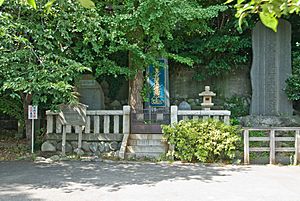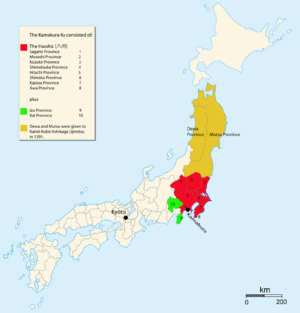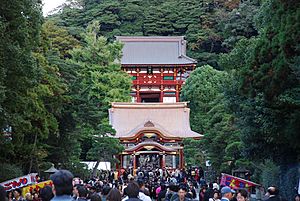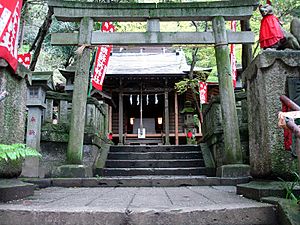Kamakura facts for kids
Quick facts for kids
Kamakura
鎌倉市
|
|||
|---|---|---|---|
|
From top, left to right: Tsurugaoka Hachimangū, Daibutsu (giant Buddha) at Kōtoku-in, Kenchō-ji, Kamakura-gū (Ōtōnomiya), and Egara Tenjin Shrine
|
|||
|
|||

Kamakura in Kanagawa Prefecture
|
|||
| Country | |||
| Region | Kantō | ||
| Prefecture | Kanagawa Prefecture | ||
| First official recorded | 1063 | ||
| City Settled | November 3, 1939 | ||
| Area | |||
| • Total | 39.67 km2 (15.32 sq mi) | ||
| Population
(September 1, 2020)
|
|||
| • Total | 172,929 | ||
| • Density | 4,359.2/km2 (11,290.2/sq mi) | ||
| Time zone | UTC+9 (Japan Standard Time) | ||
| – Tree | Yamazakura (Prunus jamasakura) | ||
| – Flower | Gentian | ||
| Phone number | 0467-23-3000 | ||
| Address | 18-10 Onarimachi, Kamakura-shi, Kanagawa-ken 248-8686 | ||
Kamakura (鎌倉, Kamakura, [kamakɯɾa]) is a city in Kanagawa Prefecture, Japan. It's located in the Kantō region on the island of Honshu. As of September 2020, about 172,929 people live there. The city covers an area of 39.67 square kilometers. Kamakura became an official city on November 3, 1939.
Kamakura is one of Japan's old capitals, like Kyoto and Nara. It was the center of the Kamakura shogunate, Japan's first military government, from 1185 to 1333. This government was started by Minamoto no Yoritomo. After the shogunate ended, Kamakura became less important for a while.
However, during the Edo period, it became a popular place for tourists from Edo (now Tokyo). Even though a big earthquake in 1923 damaged many historical sites, Kamakura is still a major tourist spot. People visit for its famous landmarks like Tsurugaoka Hachimangū and the Great Buddha of Kamakura.
Contents
- Exploring Kamakura's Landscape
- Kamakura's Main Street: Wakamiya Ōji
- Kamakura's Population Growth
- Kamakura's Rich History
- Nichiren's Connection to Kamakura
- Famous Places to Visit in Kamakura
- Kamakura's Fun Festivals and Events
- Understanding the Shakadō Pass
- Exploring Yagura Tombs
- Getting Around Kamakura
- Learning in Kamakura
- Kamakura's Sister Cities
- Other Interesting Places
- Images for kids
- See also
Exploring Kamakura's Landscape

Kamakura is like a natural fortress. Hills surround it on the north, east, and west. To the south is the wide-open Sagami Bay. In the past, it was hard to enter Kamakura by land. There were only narrow, man-made paths called the Kamakura's Seven Entrances (鎌倉七口). These paths made Kamakura a very strong place to defend.
The first leader of the Kamakura shogunate, Minamoto no Yoritomo, chose Kamakura as his base. He liked that it was his family's ancestral land. He also chose it because its natural defenses made it a great stronghold.
North of the city is Mt. Genji (源氏山, Genjiyama) (92 meters tall). This mountain goes behind the Daibutsu (Great Buddha) and reaches the sea. To the east, Kamakura is surrounded by other mountains like Mt. Rokkokuken (147 meters) and Mt. Ōhira (159 meters). Many narrow valleys branch off from Kamakura's flat areas.
The Namerigawa river flows through Kamakura. It starts in northern Kamakura and ends at Yuigahama beach. The river is about 8 kilometers long.
Kamakura city borders Yokohama to the north, Zushi to the east, and Fujisawa to the west. The city grew by combining with nearby towns and villages over time.
Kita-Kamakura: A Historic Area
Yamanouchi, Kanagawa
Northwest of Kamakura is Yamanouchi, often called Kita-Kamakura. This area was not technically part of old Kamakura. It was outside the Seven Entrances. Yamanouchi was the northern border of the city during the shogunate. Important passes like Kobukorozaka and Kamegayatsu Pass led directly to it.
Even though it's small, Yamanouchi is known for its traditional feel. It has three of the five most important Zen temples in Kamakura. These temples were built here because Yamanouchi was the home of the Hōjō clan. This family ruled Japan for 150 years. Famous people like artist Isamu Noguchi and movie director Yasujirō Ozu lived in Kita-Kamakura. Ozu is buried at Engaku-ji.
Kamakura's Main Street: Wakamiya Ōji
Wakamiya Ōji
A key feature of Kamakura is Tsurugaoka Hachiman-gū. This Shinto shrine is in the city center. A 1.8-kilometer road, called Wakamiya Ōji, runs from Sagami Bay straight to the shrine. This is Kamakura's main street.
Minamoto no Yoritomo built Wakamiya Ōji. He wanted it to be like Kyoto's Suzaku Ōji. It used to be much wider, with canals and pine trees along its sides.
As you walk from the beach to the shrine, you pass through three torii (Shinto gates). They are called Ichi no Torii (first gate), Ni no Torii (second gate), and San no Torii (third gate). Between the first and second gates is Geba Yotsukado. Here, riders had to get off their horses to show respect to the shrine.
About 100 meters after the second gate, the dankazura begins. This is a raised path lined with cherry trees. It makes the center of Kamakura. The dankazura gets wider as you walk towards the shrine, making it look longer. Minamoto no Yoritomo had it built to pray for his son's safe birth. The dankazura was shortened in the 1800s for the new Yokosuka Line railway.
In Kamakura, wide streets are called Ōji. Narrower streets are Kōji. Small streets connecting them are zushi, and intersections are tsuji. Several main streets were built during the shogunate and are still used today.
Kamakura's Population Growth
The number of people living in Kamakura has stayed quite steady in recent years.
| Historical population | ||
|---|---|---|
| Year | Pop. | ±% |
| 1920 | 29,692 | — |
| 1930 | 42,206 | +42.1% |
| 1940 | 56,598 | +34.1% |
| 1950 | 85,391 | +50.9% |
| 1960 | 98,617 | +15.5% |
| 1970 | 139,249 | +41.2% |
| 1980 | 172,629 | +24.0% |
| 1990 | 174,307 | +1.0% |
| 2000 | 167,583 | −3.9% |
| 2010 | 174,314 | +4.0% |
| 2020 | 172,710 | −0.9% |
Kamakura's Rich History
Early Days of Kamakura
People have lived in the Kamakura area for at least 10,000 years. Tools from the Old Stone Age have been found here. During the Jōmon period, the sea level was higher. Much of Kamakura's flat land was underwater. Later, the sea went down, and farming became important during the Yayoi period.
Some old writings describe pre-shogunate Kamakura as a quiet place. However, by the Nara period (around 700 AD), there were already temples and shrines. Sugimoto-dera, one of the city's oldest temples, was built then. Kamakura was also a center for government and trade routes. This made it an important city, which likely caught Yoritomo's eye.
What Does "Kamakura" Mean?
The name Kamakura has been around for a long time. It appears in old Japanese texts from the 700s and 900s. But the city truly became famous when Minamoto no Yoritomo started the Kamakura shogunate in 1192.
There are different ideas about where the name comes from. One popular theory says Kamakura is like a cooking hearth (kamado) or a warehouse (kura). This is because it's surrounded by mountains on three sides, with only one open side.
Another story is a legend about Fujiwara no Kamatari. He supposedly found a special spear (kamayari) and enshrined it in a place called Ōkura. Kamayari and Ōkura then combined to form Kamakura. However, this legend likely came about later.
The Kamakura Period: A New Era
Kamakura period

The time from Minamoto no Yoritomo's birth to his sons' deaths is very important in Japanese history. It has inspired many stories, plays, and even video games. It helps us understand much of what we see in Kamakura today.
Yoritomo's family, the Minamoto clan, was almost wiped out by the Taira clan. But Yoritomo managed to rise from being a fugitive to the most powerful man in Japan. He defeated the Taira clan and founded the Kamakura shogunate. This government lasted 141 years and greatly changed Japan.
Historians call this time the Kamakura period. It's debated exactly when it started, but it ended with the Siege of Kamakura (1333). During this period, power shifted from the Emperor in Kyoto to Yoritomo in Kamakura. Kamakura became a strong political, cultural, and economic center.
In 1179, Yoritomo married Hōjō Masako. This marriage had big effects on Japan. In 1180, he moved into Kamakura and built his home in a valley called Ōkura. A stone marker there says:
737 years ago, in 1180, Minamoto no Yoritomo built his mansion here. He ruled from home, and his government was called Ōkura Bakufu. His sons Yoriie and Sanetomo followed him. This place was the government's seat for 46 years until 1225. Then it moved to Utsunomiya Tsuji.
In 1185, Yoritomo's forces defeated the Taira. In 1192, the Emperor gave him the title of Sei-i Taishōgun (military leader). However, Yoritomo became suspicious of his own brothers. He had his younger brother Yoshitsune killed in 1189 and another brother, Noriyori, in 1193.
In 1199, Yoritomo died at age 51 after falling from his horse. His 17-year-old son, Minamoto no Yoriie, became the next leader. But Yoriie's maternal grandfather, Hōjō Tokimasa, became his regent, holding the real power. The Hōjō clan wanted to get rid of Yoritomo's supporters and gain more power. They fought and defeated many other clans. Yoriie tried to get his power back but failed and was killed in 1204. His young sons were also killed or forced to become priests. From then on, the Hōjō clan held all the real power, and the shōgun was just a figurehead.
Yoritomo's second son, Minamoto no Sanetomo, became the third shōgun. He mostly focused on writing poetry. In 1219, his nephew Kugyō assassinated him. Kugyō was then executed himself. This meant the Minamoto family, who started the shogunate, ended just 30 years later.
In 1293, a strong earthquake hit Kamakura, killing 23,000 people and damaging the city. After the earthquake, the Hōjō leader, Hōjō Sadatoki, had his subordinate Taira no Yoritsuna and 90 followers killed.
The Hōjō family continued to rule until Nitta Yoshisada defeated them in 1333 during the Siege of Kamakura (1333). During the Hōjō rule, many of Kamakura's famous temples and shrines were built. These include Tsurugaoka Hachiman-gū, Kenchō-ji, and Engaku-ji. That's why the Hōjō family crest is still seen everywhere in Kamakura.
By the mid-1200s, the system of land ownership weakened the shogunate. This, more than anything else, led to the Hōjō's downfall. Some historians believe Kamakura was the largest city in Japan by 1200 AD, with 200,000 people in 1250 AD. However, others argue that Kyoto was still very important, and Kamakura was more of a rival power center.
The Fall of the Kamakura Shogunate
Siege of Kamakura (1333)
On July 3, 1333, the warlord Nitta Yoshisada, who supported the Emperor, attacked Kamakura. He wanted to bring back imperial rule. After trying to enter by land, his forces waited for low tide. They bypassed the Inamuragasaki cape, entered the city, and took control.
Records say that nearly 900 Hōjō samurai, including their last three leaders, died at their family temple, Tōshō-ji. The city was looted, and many temples were burned. Many citizens also took their own lives. In 1953, 556 skeletons were found near Tsurugaoka Hachiman-gū. These were people who died violently, likely by Nitta's forces.
Kamakura in Later Periods
The fall of Kamakura began a period of chaos and war in Japan called the Muromachi period. Kamakura's decline was slow. For a while, it remained important as the capital of the Kantō region. However, it was eventually almost completely destroyed.
After 1333, the Kantō region remained unstable. In 1335, Hōjō Tokiyuki tried to bring back the shogunate by force. He defeated Ashikaga Tadayoshi but was then defeated by Ashikaga Takauji.
Takauji, who founded the Ashikaga shogunate, first set up his home in Kamakura. But in 1336, he moved to Kyoto. He left his son Yoshiakira in charge of Kamakura. Kamakura then became the capital of the Kamakura-fu (鎌倉府), a large region in eastern Japan.
Kamakura's ruler was called the kantō kubō. This title was like a shōgun for the Kantō region. The first kantō kubō was Ashikaga Motouji, Takauji's son. However, the Kamakura administration often rebelled against the main shogunate in Kyoto. This led to a power struggle between the two branches of the Ashikaga clan. Kamakura had to be retaken by force in 1454. The last kantō kubō had to flee.
A long period of war, the Sengoku period, followed. Kamakura was badly damaged in 1454 and almost completely burned in 1526. Many people moved away. The final blow came in 1603 when the Tokugawa shogunate moved the capital to nearby Edo (Tokyo). Kamakura never fully recovered and became a small fishing village again.
Kamakura in Modern Times
After the Meiji Restoration, Kamakura's historical sites, beach, and unique charm made it popular again. However, its heritage continued to suffer. In 1868, during a time of anti-Buddhist violence, many temples were damaged. Shrines and temples had to separate their Buddhist and Shinto elements. For example, large wooden statues from Tsurugaoka Hachiman-gū were moved to Jufuku-ji. Some temples were even closed.
In 1890, the railroad reached Kamakura, bringing tourists and new residents. This led to new prosperity. Part of the old dankazura (the raised path) was removed to make way for the new Yokosuka Line.
In 1923, a major earthquake, the Great Kantō earthquake, caused more damage. Its center was near Kamakura. The earthquake and a tsunami caused widespread destruction. Over 2,000 people died. Large parts of the shore slid into the sea, and the beach area near Kamakura was raised by about six feet.
Many temples needed to be rebuilt or restored over the centuries. This is why Kamakura has only one building listed as a National Treasure (the Shariden at Engaku-ji). Much of Kamakura's history has been lost and then rebuilt over time.
Nichiren's Connection to Kamakura

Kamakura is important for Nichiren Buddhism, which started in the 13th century. Its founder, Nichiren, was not from Kamakura. But he came here because it was the country's political center. Nichiren lived in a straw hut in the Matsubagayatsu area. Three temples there still claim to be the true heir to his teachings.
Nichiren traveled a lot, but Kamakura was always central to his religious work. It's said that he was miraculously saved from execution here. He also wrote his famous Risshō Ankoku Ron (Treatise on Peace and Righteousness) in Kamakura. Legend says monkeys once rescued and fed him here. He also preached in Kamakura.
Some important Nichiren Buddhist sites in Kamakura are:
- The three temples in Matsubagayatsu: Ankokuron-ji, Myōhō–ji, and Chōshō-ji. Ankokuron-ji claims to have the cave where Nichiren hid. Myōhō–ji was built where Nichiren lived for 19 years.
- The Nichiren Tsujiseppō Ato on Komachi Ōji. This spot has the stone where he preached to crowds. He claimed the city's problems were due to people's moral failures.
- The former execution ground at Katase's Ryūkō-ji. Nichiren was almost executed here but was saved by a miracle. This event is called the Tatsunokuchi Persecution.
- The Kesagake no Matsu, a pine tree where Nichiren supposedly hung his Buddhist stole. The original tree is no longer there.
Famous Places to Visit in Kamakura
Kamakura has many important Buddhist temples and Shinto shrines. Some, like Sugimoto-dera, are over 1,200 years old. Kōtoku-in is the most famous, with its huge outdoor bronze statue of Amida Buddha. A tsunami in the 1400s destroyed the temple that housed the Great Buddha. But the statue survived and has been outdoors ever since. This iconic Daibutsu is one of the most recognizable images of Japan. Kamakura also has the five most important Zen Temples, known as the Kamakura Gozan.
Kamakura's architecture is very special. The city has even suggested some of its historic sites for the UNESCO World Heritage Sites list. Even though the 1923 earthquake caused a lot of damage, many old temples and shrines have been carefully restored.
Some of Kamakura's top attractions are:
- The Asaina Pass and its Kumano Jinja
- Ankokuron-ji
- An'yō-in
- Chōju-ji, a funeral temple for Ashikaga Takauji
- Engaku-ji, the second highest-ranked Zen temple in Kamakura
- Hatakeyama Shigeyasu's grave
- Hōkai-ji, dedicated to the Hōjō clan
- Jōchi-ji, the fourth highest-ranked Zen temple
- Jōmyō-ji temple, the fifth highest-ranked Zen temple
- Jufuku-ji, the third highest-ranked Zen temple
- Hase-dera
- Kamakura-gū in Nikaidō, built where Prince Morinaga was held and killed
- The Kamakura Museum of Literature, a former villa
- Kamakura Museum of National Treasures
- Kanagawa Prefectural Ofuna Botanical Garden
- Kenchō-ji, the highest-ranked Zen temple and a city highlight
- Kōmyō-ji
- Kōtoku-in and its Great Buddha
- Meigetsu-in
- Moto Hachiman
- Myōhon-ji
- Ōfuna Kannon
- Katase's Ryūkō-ji
- Sasuke Inari Shrine and Hidden Village
- The Shakadō Pass (see description below)
- Sugimoto-dera
- Tamanawa Castle, castle ruins of the Later Hōjō clan
- Tatsunokuchi, where Mongol messengers were executed
- Tōkei-ji, once a refuge for women
- Tomb of Minamoto no Yoritomo
- Tsurugaoka Hachiman-gū, the city's symbol
- Wakamiya Ōji Avenue with its three torii and cherry trees
- Yuigahama, a popular beach
- Zeniarai Benzaiten Shrine, where people wash coins for good luck
- Zuisen-ji, a funeral temple for the Ashikaga kantō kubō
Kamakura's Fun Festivals and Events
Kamakura's festivals and events
Kamakura has many festivals (matsuri) and events throughout the year. They often celebrate the city's rich history. These events are usually smaller than those in Kyoto and are mostly for locals and a few tourists. January has many events because it's the start of the year. People pray for good health, safety, and a successful year. Kamakura's many temples and shrines, especially Tsurugaoka Hachiman-gū and Kenchō-ji, also host many events, adding up to over a hundred each year.
January Events
- January 4: Chōna-hajimeshiki at Tsurugaoka Hachiman-gū: This event marks the start of the working year for local construction workers. They use traditional tools for the ceremony. It also remembers Minamoto no Yoritomo, who rebuilt the shrine's main building in 1191. The ceremony is at 1:00 pm.
February Events
- Day before the first day of spring (usually February 3): Setsubun Matsuri at Tsurugaoka Hachiman-gū, Kenchō-ji, Hase-dera, Kamakura-gū, etc.: This festival celebrates the end of winter. People scatter soybeans to bring good luck.
April Events
- 2nd to 3rd Sunday: Kamakura Matsuri at Tsurugaoka Hachiman-gū and other places: This is a week-long event celebrating the city and its history.
May Events
- May 5: Kusajishi at the Kamakura Shrine: Archers in samurai clothes shoot arrows at a straw deer while reciting old poems.
August Events
- August 10 (or the following Monday if it's a Saturday): A full hour of fireworks on the beach in Yuigahama.
September Events
- September 14, 15, and 16: Tsurugaoka Hachiman-gū Reitaisai: A famous festival with many attractions. The most well-known is the yabusame, or Japanese horseback archery, which happens on the 16th.
Understanding the Shakadō Pass
Besides the Seven Entrances, Kamakura has another large pass called the Shakadō Pass (釈迦堂切通). It connects the Shakadōgayatsu area to the Ōmachi and Nagoe districts.
A plaque near the pass says its name comes from a Shakadō (a Buddhist temple for Shakyamuni Buddha). This temple was built here by the third Hōjō leader, Hōjō Yasutoki, to honor his father. The temple's exact location is unknown, and it closed in the middle of the Muromachi period. The Buddha statue from the temple is now an Important Cultural Property in Tokyo.
The Shakadō Pass was not one of the Seven Entrances because it connected two areas already inside Kamakura. Its exact creation date is unclear. However, the presence of two yagura (tombs) inside it means it dates back at least to the Kamakura period. It was an important route then, but it was much narrower and harder to use than it is today.
Inside the pass, there are two small yagura tombs with stone monuments. On the Shakadōgayatsu side, a small street leads to a large group of yagura called Shakadōgayatsu Yagura-gun. These tombs hold the bones of many Hōjō family members who died after Kamakura fell in 1333.
The pass has appeared in several Japanese films. Currently, it is closed to all traffic because of the danger of falling rocks. In April 2010, a large section of rock fell, making the road impassable for a while.
Exploring Yagura Tombs
Yagura (tombs)

A special feature of Kamakura is a type of grave called yagura. These are caves dug into the sides of hills during the Middle Ages. They were used as tombs for important people and priests. Two famous examples are the memorial tombs for Hōjō Masako and Minamoto no Sanetomo in Jufuku-ji's cemetery.
Yagura are found in the cemeteries of most Buddhist temples in Kamakura. They are also very common in the surrounding hills, with thousands estimated to exist. Many are now old and not well preserved.
The reason for digging these cave tombs is not fully known. It's thought that this tradition started because there wasn't much flat land in Kamakura for burials. The practice began during the Kamakura period (1185–1333) but became less common in the following Muromachi period.
True yagura can also be found in other parts of Japan, like the Miura Peninsula. Other regions have cave tombs, but they are not called yagura, and their connection to those in Kamakura is unknown.
Getting Around Kamakura
Train Travel
JR East's Yokosuka Line has three stations in Kamakura. Ōfuna Station is the northernmost. Next is Kita-Kamakura Station. In the city center is Kamakura Station, the main train station.
Kamakura Station is also the starting point for the Enoshima Electric Railway. This train line runs west to Fujisawa. Part of its route runs along the seashore. After leaving Kamakura Station, trains stop at eight more stations within the city. One of these is Hase Station, which is close to Hase-dera and Kōtoku-in.
Main Roads
- National Route 134 is a key highway in the area.
Learning in Kamakura
Kamakura has many schools. The city runs 16 public elementary schools and 9 middle schools. The national government has one elementary and one middle school. There are also two private elementary schools and six private middle schools. For older students, there are four prefectural and six private high schools. Kamakura also has a special school run by the prefecture.
Kamakura Women's University is the only university in the city.
Kamakura's Sister Cities
Kamakura has six sister cities. Three are in Japan, and three are in other countries:
 Nice, France (since 1966)
Nice, France (since 1966) Ueda, Nagano, Japan (since 1979)
Ueda, Nagano, Japan (since 1979) Hagi, Yamaguchi, Japan (since 1979)
Hagi, Yamaguchi, Japan (since 1979) Ashikaga, Tochigi, Japan (since 1982)
Ashikaga, Tochigi, Japan (since 1982) Dunhuang, China (since 1998)
Dunhuang, China (since 1998) Nashville, Tennessee, United States (since 2014)
Nashville, Tennessee, United States (since 2014)
Other Interesting Places
Kamakura has many historic houses. Tukikagetei is a famous one. It was built 100 years ago during the Taisho era. Today, Fukagawa Geisha use this house.
Images for kids
-
Portrait traditionally believed to be of Minamoto no Yoritomo, but now believed to be of Ashikaga Tadayoshi
See also
 In Spanish: Kamakura (Kanagawa) para niños
In Spanish: Kamakura (Kanagawa) para niños
























